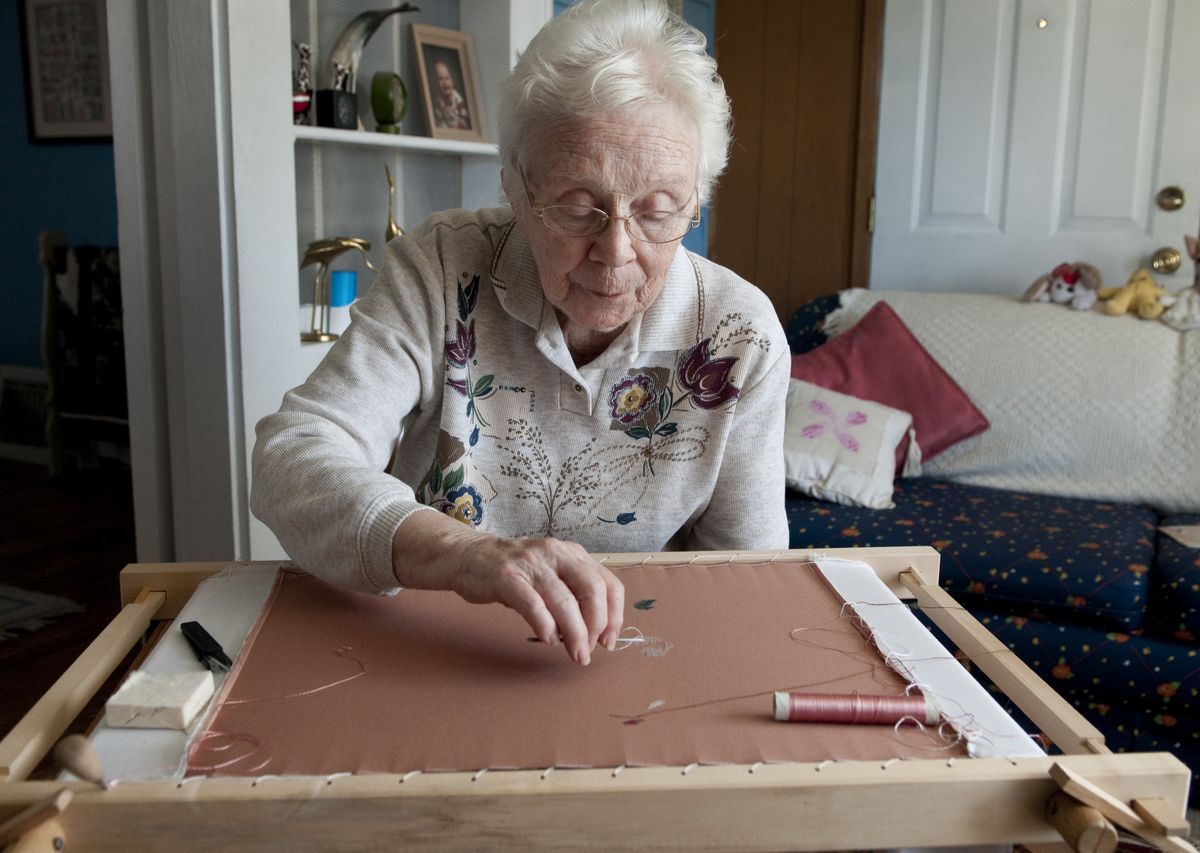Knot your mother’s needlework
Imagery, silk threads drive Japanese stitching art form

The walls in Lee McLeron’s South Hill home are covered with framed needlework – her own creations, products of a skill she learned at the tender age of 4. “I lived with my Scottish grandmother,” she recalled. “After nap, you had tea and then you worked.” Her grandmother taught her to darn, “but I flunked tatting,” she said with a smile.
However, she felt at home with needle and thread in her hands, and needlework became a lifelong passion. In the early 1990s, she grew intrigued with the ancient art of Japanese silk embroidery. Though the craft has a more than 1,000-year history, it was fairly new to the Western world at the time.
In 1993, McLeron signed up for a four-day class in Vancouver, B.C. “Like all things Japanese, you learn in phases,” she said.
And what she discovered in that first class captivated her and left her longing for more. Each March for several years, she returned to Canada to continue her studies, as it is customary to study with the same teacher or sensei.
Japanese silk embroidery is done with silk and metal threads on a silk foundation fabric. This combination of materials, coupled with traditional design, color and imagery, creates unique fabric pieces of Asian elegance.
McLeron demonstrated some of the unusual facets of this embroidery technique on a work-in-progress in her home. A dusty rose swath of silk crepe stretched across a 29-inch wooden frame. She uses very sharp, extremely fine, handmade needles, which she orders from the Japanese Embroidery Center in Atlanta. They cost $9 each. “If I’m working and miss a needle, everything stops,” she said, until she finds the tiny but valuable tool.
One of the more unusual aspects of this art is that the left hand is the dominant hand, even if you’re not a southpaw. Stitchers use this hand to push the needle up from under the frame.
“You work from top to bottom, left to right, clockwise,” she said. A printed worksheet or box chart denotes the stitches and the colors of flat, filament silk thread to be used.
The art form encompasses 46 techniques and each one requires focus and concentration.
For McLeron, that’s part of the appeal. “The idea is from mind to fingers,” she said. “I like the challenge.”
Two of her pieces are on display at the Kress Gallery, and several more adorn her walls at home. One of her earliest projects, “Ishiwa,” is a simple Japanese fan with a morning glory embossed on it. It represents 50 to 60 hours of labor.
Another piece, “Mile High,” features a stalk of bamboo rising into wispy clouds. Though exquisitely detailed, McLeron’s work embodies the traditional “less is more” Japanese philosophy.
In addition to mastering dozens of techniques, stitchers must learn how to manipulate the silk thread. “You learn how to twist,” McLeron said. She wasn’t talking about dancing. She picked up a tube of thread, snipped a long piece and rolled it in her hand. “Each strand is made up of 12 sugas,” she said. She separated two sugas and began to roll them together between her palms. “This is called an under twist.” The technique gave a soft, fuzzy look to the thread. She’ll use the twisted threads in her current project.
Stitchers can also twist colors together or add metallic thread to the silk. McLeron said, “It’s all about texture and light play.”
McLeron is thrilled that local residents will have a chance to learn this timeless craft. As part of Japan Week festivities, Kay Stanis, an internationally-known fiber artist, designer and teacher, will offer a series of Japanese Silk Embroidery classes.
“This is the first time a class has ever been in Spokane,” McLeron said.
While registration is now closed for the workshop, the public is invited to observe the final class on April 24. Those used to Western classroom settings will notice some distinct differences. Stanis teaches in the traditional Japanese way.
“We try to bring a sense of calmness and focus and give students a lot of time to do stitching,” Stanis said in a phone interview. Chitchat is discouraged, allowing students to concentrate on what’s in front of them.
That single-minded focus is soothing to McLeron.
“It’s very relaxing. I shut out the world,” she said.
In addition to the sense of calm the embroidery process gives her, she also takes great satisfaction in preserving a centuries-old craft.
“We’re keeping a very ancient art form alive,” she said.